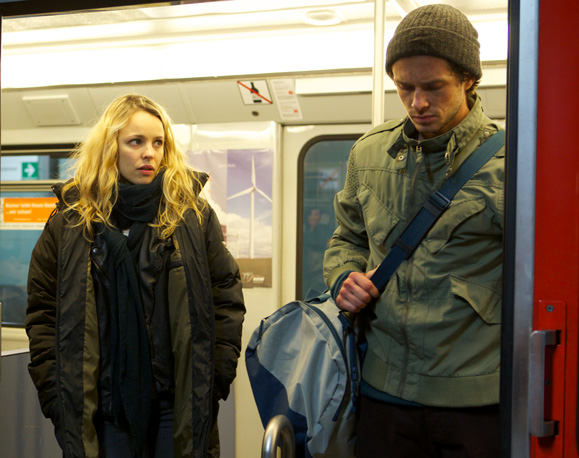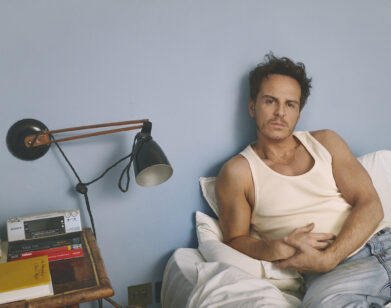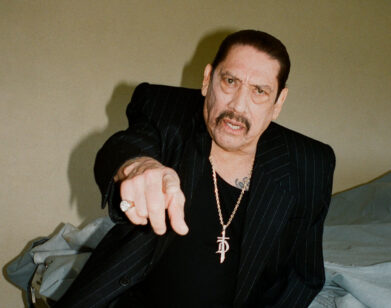Anton Corbijn’s Spy Games
Anton Corbijn has directed music videos for the U2, Depeche Mode, the Red Hot Chili Peppers, Johnny Cash, Joy Division, and Nirvana. His most striking videos are shot in a mixture of black and white and oversaturated reds and greens, which gives them the feeling of a Life magazine cover or an old film restored frame-by-frame with a colored paintbrush. As a photographer, he is something of a legend, with the most iconic musicians of the late ’70s, ’80s, and ’90s in his book—Bowie, Björk, Tom Waits. Over the last decade, Corbijn, who was born in Holland almost 60 years ago, has invested himself in feature films. Oddly, and perhaps unintentionally, his movies seem to fall into two genres: biopics of enigmatic artists who died before their time and spy films. 2007’s Control, his debut film, focused on Joy Division’s Ian Curtis. His last movie, The American (2010) starred George Clooney as a tacit man of mystery. He’s about to finish work on the James Dean film Life and, this week, his John Le Carré adaptation A Most Wanted Man comes out in New York and Los Angeles.
A Most Wanted Man, which debuted at Sundance, is the last film Philip Seymour Hoffman completed before his death—but you shouldn’t let that fact eclipse it. It is an ideal Le Carré adaptation: smarter, better acted, and more considered than most spy thrillers while still faithfully adhering to the genre. Hoffman plays Günther, a German intelligence officer based in Hamburg. When Issa Karpov, a rumored Chechen jihadist, appears in the city, Günther must establish the best course of action before the German government, or worse still, the Americans (represented by Robin Wright), bulldoze their way in. Along the way, Günther is aided by a human rights lawyer (Rachel McAdams) and a reluctant, wealthy banker (Willem Dafoe). We spoke with Corbijn yesterday afternoon in New York.
EMMA BROWN: Are you nearly finished with interviews for the day?
ANTON CORBIJN: Yeah, I think I’m nearly done. I have a few more. It’s not what I like about filmmaking. It’s not what attracted me to filmmaking. I understand the necessity.
BROWN: I’ve only heard one person say they actually enjoyed it.
CORBIJN: Really? Who was it?
BROWN: It was David Michôd, who did Animal Kingdom.
CORBIJN: Oh, right. He did The Rover.
BROWN: He was talking about the saying, “You make a movie three times—writing, filming, and editing?” He said, “I think you make it four times, and the fourth time is when you’re doing press.”
CORBIJN: Yeah. [laughs] It’s probably true. Because you see links that you never saw before. It’s a bit like being at the therapist, isn’t it? You’re starting to see all kinds of subconscious stuff.
BROWN: Oh good, because my first question is: What is the earliest memory you are willing to share?
CORBIJN: In my life? [pauses] Sometimes you don’t know if your memory is because you really experienced it or because you look at your old pictures. I have a nice picture of myself held up by my grandfather and my father standing next to me. We all have the same name—we’re all called Anton Corbijn. That’s something I cherish. For the rest, I guess it’s probably where we lived. We lived on an island and behind the house there was some water, and then you had the cemetery. That’s how I grew up—over death. [laughs]
We didn’t play in the cemetery—only later, when I was eight, I had a canoe. Then you could cross the water. Now people would be very anxious with an eight-year-old child in a canoe. I used to do it on my own. You learn to swim at a young age in Holland because there’s a lot of water around.
BROWN: Were you close with your father and grandfather?
CORBIJN: No, not really. My grandfather died when I was four and I was only close to my father very late in life. My father was a parson and had no creative element in him, but his father was a teacher of drawing and he painted in his spare time. Ten years before my father passed away, he told me that he suddenly remembered that his father—my grandfather—was a photographer, too, and had his own darkroom underneath the staircase. I said, “How could you not ever have told me that?” I thought I was a unique photographer in our family, and now it turns out my grandfather did it as well. And he goes, “Well, I never thought of it.” So that was interesting, if the creative characteristic jumped a generation. I only went once to a museum with my father, and it was a Rembrandt exhibition because my father understood paintings only by what was depicted, and they were all biblical scenes. That’s how he understood painting.
BROWN: Was your mother more invested in the arts?
CORBIJN: Only to the degree that she liked music. She played piano.
BROWN: Do you remember when you first came across the work of John le Carré?
CORBIJN: I saw the films before I read the books, so I can’t say I’m an expert on his writing. When I was editing The American (2010), I read scripts and read some books, and one of the books I read was A Most Wanted Man. That’s probably the first book I read of John le Carré.
BROWN: How involved was Le Carré during filming? I know he wrote about piece for The New York Times about meeting Philip Seymour Hoffman through the project.
CORBIJN: He was an executive producer, so I guess he had to okay me for the project. I met him a few times before Philip had gotten involved. He was a great source of knowledge of how it works, the spy world. In the film, it’s quite mundane, and that’s how spy work is done. It’s less the Jason Bourne kind, which probably makes very good films; the real spy world is more the normal, day-to-day stuff. And also how a master spy like Philip’s character, how he has to behave towards the other people. He has to be a father figure, or a lover, even. Whatever it takes to keep these people on their side and connected.
Günther is a good guy, I think. It’s a lonely struggle versus the system. You see him talking Arabic back to the guy who sells the cigarettes. He was stationed in Beirut. He’s not Islamaphobic. He’s a normal, intelligent guy—well-educated. You see his apartment; you see the books and the jazz records. He just doesn’t take very good care of himself. He’s very focused on the job at hand.
BROWN: Did you know whom you wanted for the part straight away?
CORBIJN: First I thought it should be a German cast but once I let that go, it was just Philip. Actually, my girlfriend mentioned to me straight away, it should be Philip. And once you go get Philip, there’s nobody else. He’s so exuberant.
BROWN: What about some of the other cast members—Rachel McAdams, Robin Wright, Willem Dafoe. Did they come to you as easily as Philip did?
CORBIJN: No. I think Rachel was quite quick for me. But the banker, it took a long time for me to get to Willem. I had met him before, 20 years ago or so. We did some photographs—just for myself, not for anything else. [A few years ago] he was playing in Amsterdam and a mutual friend of ours said, “Well, Willem is playing, you want to come?” So I went, and met up with Willem afterwards and we got a drink, and it was a play by Bob Wilson called The Life and Death of Marina Abramovic. He was so amazing in that play. Unbelievable. So that brought him close to mind again. I thought, “Well, maybe it’s really interesting to have an American playing that English banker role. And for Willem to not play a bad guy.” Because he has this really interesting face—you always think he’s going to turn around the corner and he’ll be bad. But [the banker] is not [bad]. He has a very lonely life, and he actually realizes he can do something good.
BROWN: You’ve worked with so many interesting people over the years. Is there anyone who really stuck out who you would love to have worked with again?
CORBIJN: Yeah. It makes me rethink, actually, a lot of what I do, because a lot of people die, and you have all these memories of these photo shoots. I’ve looked at my books and think, that person’s no longer there. That’s difficult. But at the same time, it’s amazing to me—Miles Davis and Sinatra and William Burroughs. All these people, I’ve spent time with them. Even if it’s 10 minutes or half an hour, you always take something away from it. The last book I did was called Inwards and Onwards (2011). It relates to the fact that you take something from all these meetings and you go on more knowledgeable. I always think that I could do really good Bob Dylan shots, and I’ve only photographed him once, with one picture. So if Bob reads this, he should call me. [laughs]
BROWN: Do you know immediately when you meet someone whether they’d make a good photography subject?
CORBIJN: My way in for photographing people is really their work. I’m always interested in what people make, and then I photograph the person. Sometimes the person is a disappointment. But that’s the risk. It informs me a lot about the character of a person if I know their work first. In the last few years, I’ve done an incredible amount of painters. It’s an area, for me, where there’s more mystery left. I’ve photographed so many musicians, I’ve been in studios so often, I know the whole process. The mystery’s gone from it. I think it’s important to keep mystery into our lives. There’s a longing connected with it.
A MOST WANTED MAN COMES OUT FRIDAY, JULY 25, IN SELECTED CINEMAS IN NEW YORK AND LOS ANGELES.







